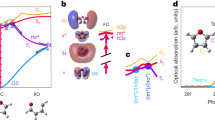Abstract
IN Roy. Soc. Proc., A, vol. 104, p. 455 (1923), I gave the results of measurements of a number of “soft” X-ray absorption levels. The1 v/R values of the levels were deduced from the kinetic energies of the groups of electrons expelled from the atoms by X-rays of known frequency. In most cases the results agreed very well with the values deduced from spectroscopic X-ray data, but fairly wide systematic deviations were observed in the case of the K levels of the light atoms—my values being appreciably higher than those previously accepted. In the case of the oxygen K level the value of v/R came out 42.3, which is 4 units—more than 50 volts—greater than Kurth's value of the K critical excitation potential for oxygen (Kurth, Phys. Rev., 18, p. 461, 1921).
This is a preview of subscription content, access via your institution
Access options
Subscribe to this journal
Receive 51 print issues and online access
$199.00 per year
only $3.90 per issue
Buy this article
- Purchase on Springer Link
- Instant access to full article PDF
Prices may be subject to local taxes which are calculated during checkout
Similar content being viewed by others
Author information
Authors and Affiliations
Rights and permissions
About this article
Cite this article
ROBINSON, H. The K Absorption Levels of the Light Atoms: a Correction. Nature 115, 945–946 (1925). https://doi.org/10.1038/115945b0
Issue Date:
DOI: https://doi.org/10.1038/115945b0
Comments
By submitting a comment you agree to abide by our Terms and Community Guidelines. If you find something abusive or that does not comply with our terms or guidelines please flag it as inappropriate.



